Jane Jacobs begins by explaining how a district in order to be successful must be in constant use. she uses lower manhattan as her example. The businesses in lower manhatten are used mainly during the lunch hours, between 12-and 2pm. after that there is minimal use of these businesses. Jacobs explains that this is because lower manhattan is a financial center and is used mainly by workers. she tells us that many of the businesses are moving to midtown where they are used for longer periods of the day. she explains that the city is aware that if this continues lower manhattan will slowly dwindle and die out. as a result the city has planned to erect housing, theorizing that if people live in this district they will use its shops during a larger range of hours. The urban planners are also intending to build more manufacturing plants. Jacobs criticizes the urban planners explaining that building new manufacturing plants would increase the 9-5 nature of this part of town, and also deprive other parts of the city that really need manufacturing plants. I assume she is saying this because if other parts of the city have manufacturing plants, then the people who work at those plants will have to travel to them. Increasing the amount of travel people do should theoretically increase the liveliness/revenue of a city. it costs money to travel, whether that be parking, taking the train, or a taxi. also, people who travel to other parts of the city are more likely to leave their district and go to other districts and increase revenue in those districts.
In Jacobs explanation of the problem with Lower Manhattan, I couldn't help but think of Atta Kim's Long Exposure series, in which he uses long exposures to create a world that appears uninhabited but due to sometimes barely noticeable trails, has a ghost like quality. As if something may have lived there once, but is no longer. This is how I imagine Lower Manhattan to be after 5 or 6 o'clock, when all the workers have gone home.
Jacobs offers an alternative plan. Her plan is one that would increase tourism to this district, drawing visitors at leisure hours and on weekends. Her plan would have a free marine museum (including an aquarium and permanent collection of marine vessels) built on the lower manhattan waterfront, which she claims is currently underutilized. Jacobs also claims that the lower manhattan waterfront could be utilized as an embarkation point for "pleasure voyages in the harbor and around the island" she explains that this in turn would produce new sea food restaurants. She explains that related attractions could be featured inland, "deliberately to carry visitors father in easy steps." Then she plans for a public library to be built, one which would specialize in all marine and financial lore. She says that as the district "livened up during evenings and weekends we could expect some new residential use to appear..."
Jacobs theorizes that if a district is calculated and specialized for one function will be unable to provide what is necessary if it is confined to that one function. This is due to the fact that the district will only be used during specific times and because of its lack of diversity, at all other times will be empty.
Jacobs describes something she calls "secondary diversity" which is "a name for the enterprises that grow in response to the presence of primary uses, to serve the people the primary uses draw." This is essentially eateries and shopping related to the primary use.
Jacobs explains that for a district to be effective it must do a few things:
First, the people using the street must use the same streets, their paths cannot be separated, or else segregation will happen.
Second, the people using the same street at different times must include, among them, people who will use some of the same facilities. Her example where this is NOT happening is an Opera house that is being put into a low income neighbourhood.
Lastly, she says that the mixture of people using the street during the day must be somewhat similar to those using it at night.
Jacobs talks about the Central Business District (CBD). She explains that traditionally city centers had all four necessary conditions for generating diversity. Yet now they are missing one component; they are unused after the hours of work. Basically suffering from the same problem Lower Manhattan is posed with.
I relate the issue Lower Manhattan is facing to The South Loop of Chicago. Although I am not sure that any action is being taken about the problem. The South Loop is also suffering from lack of mixed primary uses. Below is a graph which depicts the issues at hand.











